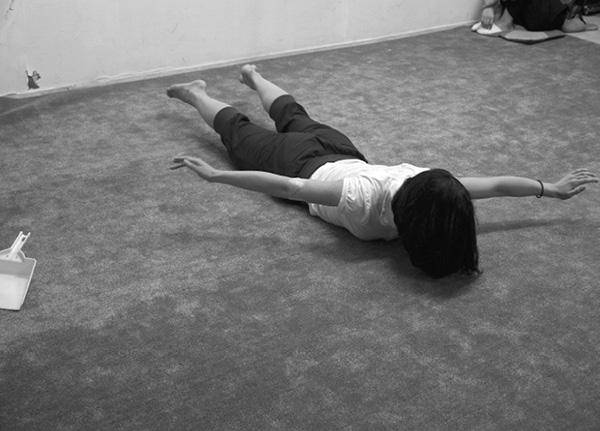
POSITION DOUBTFUL
first performed on
July 16, 2011
blanClass, Yokohama, Japan
performed once in 2011
ZEN-GO
Shinichi Takashima and Megumi Kamimura
489516440u489516440n489516440i489516440t489516440.489516440z489516440e489516440n489516440g489516440o489516440@489516440g489516440m489516440a489516440i489516440l489516440.489516440c489516440o489516440m
POSITION DOUBTFUL
ZEN-GO
How do we deal with the physical body thoroughly as an object? It would be the process to rip off various kinds of meanings, which the body is usually given and to reduce the body to the point where it is no more or no less than just a body. It might look paradoxical, but we start with imitating objects and the ways they are, in order to approach the solution of this problem. That is to say, we substitute or translate one thing to other things in different levels or qualities; from an action to a word, from a word to an object, from an object to range or space. Everything has functions no matter if it is an object or a human being. In other words, the functional constancy in objects corresponds to the custom or social position in the human beings. By extracting and imitating these functions/customs, we start to find ourselves behaving in unknown ways. We want to rediscover the human body as an object moved by the function, not by the will or the conscious mind.
A description of “Partner Loss” (section 3 in “Position Doubtful”):
One performer chooses one from a group of tools, which are to be used in pairs; for example, pencil and eraser, hammer and nail, knife and cutting board, curtain and curtain rail, etc. He/she performs as one of such tools without its partner. It’s preferable to choose a tool that is dependent on the partner for its performance or existence (i.e., “a cutting board without a knife” is less likely to pose the function than “a knife without a cutting board” does).
In the case “a broom without a dustpan” is chosen:
-
Performer picks up a dustpan to place it beside him/her, and says to the audience, “I need a dustpan.”
-
Imitates the figure of the broom and the movements when it is normally used.
-
Supposes the situation that the broom has to work when the dustpan is lost.
-
Staying as the broom, plays the part of the dustpan (the broom imitates the dustpan), e.g., keep the figure of the broom, but try to move as the dustpan.
-
Tries to transform to a dustpan from the broom.
-
Invents new ways of working of the broom without the dustpan.
-
Prays for the dustpan in order to be released from its memory.
While one performer is going through this process, the other one watches him/her and writes on the blackboard the description of what he/she is doing.